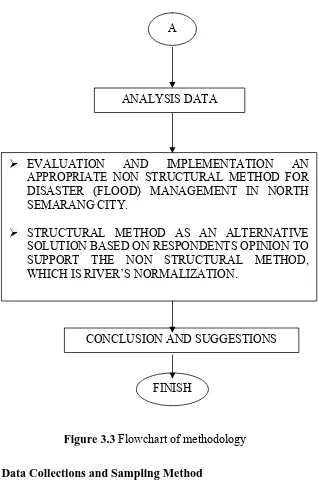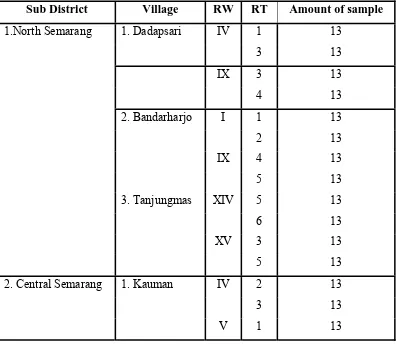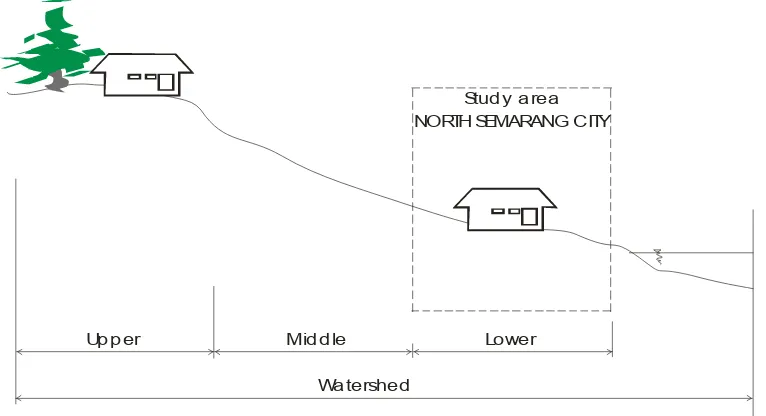CHAPTER III
METHODOLOGY
.1. Conceptual Approach 3
thing complicated, because it involves many cience disciplines. For instance, there are hydrology, hydraulic, morphology and
structural method. This final assignment is based on non structural measures to manage the disaster, especially flood impacts. This non structural measure is including:
Watershed management
Law-enforcement.
Environment conservation.
Land use regulation.
Flood warning system, etc
All m sures above are being part of disaster management system. Therefore, this final assignment is expected give an appropriate measures to overcome flood problems which occur in north Semarang city. The measures are obtained from analyzing primer data and secondary data. The management disaster is applied for the m sures that had obtained. The analysis is using three strategies, there are (Grigg, 1996):
a. ood damage and disruption.
b. Modify the impact of flooding on individual and the community. In the reality, flood control is some
s
sedimentation of river, system of drainage, social, economic, politic etc. Success of flood control is determined by many aspects, such as public participation. Therefore, strategies are needed to overcome flood and the impacts which might be produce. There are two methods that can be used to overcome these problems, non structural and structural method. Non structural method is a method to mitigate disaster without construct technical building to control flood. Flood control without constructing building will give significant advantages. In other ways, non structural method gives more contribution, because it is more effective and cheaper than structural method. This study will more focus on non
ea
ea
c. Restore and preserve the natural and cultural resources of floodplain.
From those strategies, assessment to identify the implementation of non structural method in north Semarang city. The detailed of conceptual approach shows on figure 3.1 and figure 3.2.
.2. Analytical Frame Work
this final assignment is identification problems, then bservation to the field to find the real problems. Literature study is used for finds
e reference of suitable solutions to overcome the problems. Afterward, data are ollected as input which will be a ng the output. The output of this tudy is value which illustrated the percentage of implementation on north
emarang city. Afterward, measures will be obtained by correlated the value with e reference which represen . Therefore, those measures ere illustrating the disaster management which expected will overcome the flood roblems in north Semarang city. The flow chart is given as follows:
was done
3
In begun from the
o th
c nalyzed for getti
s S
th ted non structural method
START
PROBLEMS IDENTIFICATION
OBSERVATION
LITERATURE STUDY
DATA COLLECTION
PRIMARY DATA SECONDARY DATA
FIELD SURVEY:
QUESTION
INTERVIE
INSTITUTIONS SOURCE: USE, MAP DATIONS
BPS: DEMOGRAPHY NAIRE
W
PU: LAND OF INUN DATA
NO
YES ARE DATA ENOUGH?
.3. Data Collections and Sampling Method
.3.1. Data Collection Method
The collec Statis Sema Dina
A
ANALYSIS DATA
¾ EVALUATION AND IMPLEMENTATION AN
APPROPRIATE NON STRUCTURAL METHOD FOR
IVER’S NORMALIZATION.
DISASTER (FLOOD) MANAGEMENT IN NORTH SEMARANG CITY.
¾ STRUCTURAL METHOD AS AN ALTERNATIVE SOLUTION BASED ON RESPONDENTS OPINION TO SUPPORT THE NON STRUCTURAL METHOD, WHICH IS R
CONCLUSION AND SUGGESTIONS
FINISH
Figure 3.3 Flowchart of methodology
3
3
are p this s
a. Survey
In order to collect primary data needed. The techn primary data collection is:
• Visual observation, which direct inspection to the study area, that is done to evaluate the attain from secondary survey with the actual condition in th as adding information which can not be obtained by sec
• Questioner distribution, w distinguish the expe ng inhab the input of non stru measure method for disas ent to overcome floods i in north Semarang City. The respondents chosen are the bureaucrats,
s.
• Interview, which means t ation directly from the local inhabitants. The activity is done in the unstru
en distributing questionnaire or when searching data in tutions.
survey
3.3.2.
a.
opulation is the overall of individual in area, in certain time which target of research (Sugiarto, 2001). Population in this rimary data which are formed as outcomes of observations in relation with tudy.
on field area
, primary survey is ique of
ed information e area, as well
ondary survey.
hich is done to rts and
the north Semara itant’s opinion for ctural
ter managem mpact
and inhabitant
o collect inform
of interview ctured
interview wh the related insti
b. Institution
The secondary data collections are performed by secondary survey, which is survey to some relevant institutions, are Bappeda, BPS, and PU.
Sampling Method
Population P
matching with the
Table 3.1 The amount of population on study area (North Semarang, Central Semarang, East Semarang Sub District, 2006)
Sub District Village Total Population
1. North Semarang 1. Panggung Lor 2. Panggung Kidul 3. Kuningan
6. Bandarharjo 19322
29343 7. Tanjungmas
2. Central Semarang 1. Purwodinatan 2. Kauman 3. Pandansari
4880 4080 3683 3. East Semarang 1. Kemijen
2.
13362
Bugangan 9354
3. Mlatiharjo 6061
Total population 143371
(Source: BPS, 2005
b Sample
Sample is overall of individual to become set of analysis in competent population and according to made / to be pulled as research sample as according to fram sample (Sugiarto, 2001). A sample is a small representation of the whole population rget. e use of sam ng allows for more adequate b king the time of the scientific worker count.
c Sampling Method
n osen sa ing thod is rand sampling, which is a method of probability sampling in which the selection of respondents is random. The random sam ng uses a representative number of subjects from various sub groups which are randomly selected. A
)
.
e
ta Th pli
scientific work y ma
.
In this final assig ment, the ch mpl me om
probability sampling m any m o pl e form of random selection. In probabilistic sampling method each unit in population have eq cho sam of the who pulation. In order to have a random selection me od, m st set up som rocess or procedure that assures that the different units in population have equal probabilities of being chosen. Sample could get by some method, there are
of ra earch se drawing m od, which passing some phas awing me d can be shown on table 3.2 below.
1. 13 villages from Sub District select 8 vi es. 2. 8 villages select
3. 16 RW selected 32 RT.
Tabel 3.2 Sample result from sampling alysi of north S rang city population (Simple Random
Sub District Village RW RT Amount of sample ethod is ethod f sam ing that utilizes som
ual chance to be sen ple le po
th u e p
drawing, table ndom number. This res u eth e. The result of dr tho
3 ed llag
ed 16 RW.
an s ema
sampling)
1.North Semarang 1. Dadapsari IV 1 13
3 13
IX 3 13
4 13
2. Bandarharjo I 1 13
2 13
IX 4 13
5 13
3. Tanjungmas XIV 5 13
6 13
XV 3 13
5 13
2. Central Semarang 1. Kauman IV 2 13
3 13
Sub District Village RW RT Amount of sample
2 13
2. Purwodinatan I 3 13
5 13
II 1 13
3 13
3. East Semarang 1. Kemijen I 3 13
5 13
V 1 13
6 13
2. Mlatiharjo I 1 13
3 13
III 2 13
5 13
3. Bugangan V 5 13
7 13
VII 1 13
4 13
(Analysis, 2006)
Time and financial consideration in this study are important factors that can be considered with the data analysis plan. Due to deciding the sample amount of this
tudy, the formula used that suitable with this study methodology is: s
1
)
(
×
2+
=
d
N
N
n
n = the required sam N = the known and estim d = precision level Where:
ple amount
Data calculation:
90% of respondents are representing the
ng city is 143371 populations. Therefore,
ount is taken The precision level used ranges 1%-10%, this research used 5% which means that
whole, or in other word valid. The
population of research on north Semara
the required sample amount as calculated with the above formula for this study is
398, 9 which is then cumulate as 400 respondents. The sample am
with the calculation of the total sample number (400 respondents) divided into 32
RT which selected randomly, from the calculation is obtained 13 respondents each
RT, the result shows on Table 3.2 above. The spatial scope of sample location can
be seen on figure 3.4 below.
study is the data which relevant with the research aims. The
ata consist of primary data which is gathered from questionnaire and interview
Figure 3.4 Study areas on north Semarang City
3.4. Data Requirements
The data used in this
with respondents and data secondary which is collected from the relevant
institutions.
3.5. Analysis Technique
1. Collecting data, Data summary, Data appearance
The data which have been obtained will present detailed by tables and
diagrams as summary. Furthermore, data are processed and find the
correlations with the disaster management then shown to graphs or
diagrams. This phase is meant to facilitate read data.
2. Analysis data, Correlation the result of data summary with the system
disaster management
Data which have summarized will be analyzed. From this analyzed, the
correlations between data summary and the management disaster will be
find and this correlations will create the measures which representatives the
management of disaster to overcome the flood problem in north Semarang
City.
. Election of non structural measures which could be applied to overcome
From t l be selected furthermore applied to
acity discharge.
emarang river has been selected to be improved, because this river was passing
g river’s 5 years return discharge was higher than
ver’s capacity. Therefore, it needs to be normalized, for Semarang River’s
normalization. It will use single trapezoidal channel design. 3
flood in North Semarang
he analysis, the measures wil
overcome flood problems in north Semarang.
3.7. Analysis of Structural Method as an Alternative Solution
As shows on conceptual approach, the successful of flood coping was depend on
the implementation of Structural and Non Structural method. Structural method
has many types, for this final assignment will analysis river normalization. The
river normalization is a method for improving the river’s cap
S
the flood prone area. Semaran



